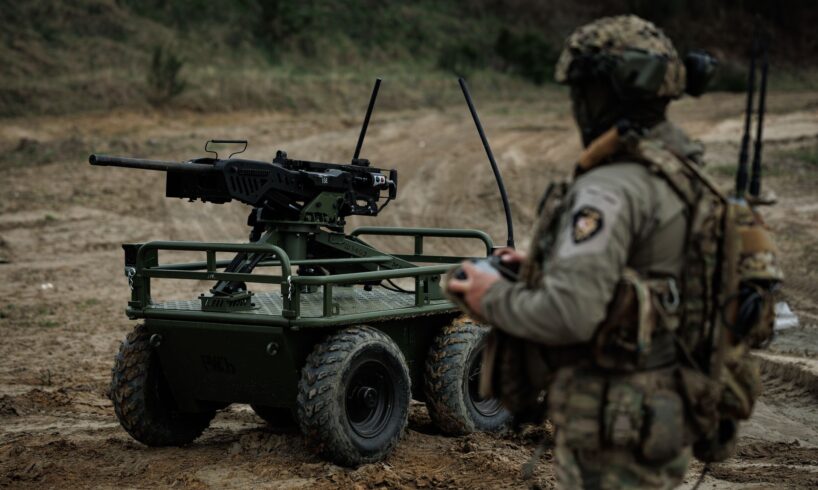
Ukrainian soldiers of the 214th Separate Assault Battalion OPFOR operate the Rys Pro unmanned ground vehicle platform equipped with a remote-controlled machine-gun turret during training in Ukraine on April 18, 2025. (Serhii Mykhalchuk / Global Images Ukraine via Getty Images)
Ukraine’s use of unmanned ground vehicles (UGVs) has accelerated in recent months, a development experts say could help ease pressure on infantry as Kyiv struggles with ongoing recruitment problems and losses.
Ukraine’s first confirmed UGV — often referred to as ground drones — combat mission took place in December 2024, when the Charter Brigade used one in Kharkiv Oblast. It was the first time a homegrown UGV had participated in a full battlefield operation.
Developments have come thick and fast since and just last week Ukrainian forces for the first time captured Russian troops without the use of infantry, relying solely on drones and ground-based robotic systems.
“Their biggest impact might be that Ukraine could eventually need fewer troops at the frontline,” Jakub Janovsky, an analyst with Oryx, a Dutch open-source intelligence and defense research group, told the Kyiv Independent.
“And fewer in support roles — logistics, casualty evacuation, and everything that keeps the front running.”
Ukraine is facing a growing manpower gap as Russia outpaces it in monthly recruitment. President Volodymyr Zelensky said in May that Russia mobilizes about 40,000 to 45,000 men each month. Ukraine manages just 25,000 to 27,000.
Despite losing more than a million troops since the full-scale invasion began, according to figures from Kyiv, Russia continues to attract new recruits with huge financial incentives.
Ukraine has expanded its draft and offered new incentives, but shortages remain. This puts extra pressure on infantry and increases the value of UGVs that can take on high-risk tasks.
What is an unmanned ground vehicle (UGV)?
UGVs are remotely operated, ground-based robots built to perform military tasks without putting soldiers at direct risk.
They come in various shapes and sizes, from small tracked carriers to heavier, armored platforms. Most are modular, meaning they can be fitted with tools, sensors, weapons, or medical gear depending on the mission.
While they do not operate independently, UGVs extend what troops can do on the battlefield by acting as mobile helpers and force multipliers in high-risk zones.
“To command a UGV, you need a crew.”
Some models are armed with light machine guns or explosive payloads. Others carry ammunition, food, or water through exposed terrain where human troops would be at high risk.
Medical UGVs extract the wounded from frontline zones, a task often too dangerous for medics or infantry.
A THeMIS multi-purpose tracked unmanned ground vehicle during field tests in Kyiv, Ukraine, on Sept. 8, 2022. (Mykhaylo Palinchak / SOPA Images/LightRocket via Getty Images)
Despite their growing presence and their proven utility, these machines are not autonomous and are not a one-for-one replacement for troops.
“To command a UGV, you need a crew,” Captain Oleksandr Yabchanka, a commander with the Da Vinci Wolves battalion, told the Kyiv Independent
“So far, we haven’t reduced personnel, we’ve reduced risk.” He added that UGVs are helping take over some of the most dangerous tasks, helping troops hold their positions more safely.
Yabchanka said his unit uses several types of UGVs tailored to different missions. Some of the UGVs already in action with Ukraine’s armed forces include:
Liut
The Liut system, equipped with a 7.62 mm machine gun, has passed combat testing in real battlefield conditions.
It can identify and engage targets day and night, and its quiet electric motor and rugged build allow it to operate across challenging terrain and in harsh weather.
Ukraine’s military intelligence (HUR) earlier this week released a video of one in action.
“Having reached enemy positions, it destroys the Russian occupiers with dense machine gun fire. The armed and technological fight for Ukraine’s freedom continues,” HUR wrote on Telegram.
Footage released on July 14, 2025, shows the Liut (Fury) robotic platform in Sumy Oblast attacking Russian positions. (Ukraine’s military intelligence agency / Telegram)
Termit
Termit is a next-generation version of tracked UGV that can carry up to 300 kilograms and operate on various terrains thanks to its low profile, tracked design, and improved weight distribution.
Ukraine’s domestically produced unmanned ground vehicle Termit. (Ukraine’s Defense Ministry)
According to the Defense Ministry, Termit drones can be equipped with combat modules, used for medical evacuations, or for transporting specialized equipment as needed.
D-21-12R
Equipped with a large-caliber machine gun, the catchily-titled D-21-12R is capable of conducting surveillance, patrolling, providing fire support to the Ukrainian military, and targeting Russian lightly armored vehicles.
The Ukrainian-made D-21-12R ground robotic system. (Courtesy/Ukraine’s Defense Ministry)
It has high cross-country ability in off-road terrain, mud and shallow water and can be operated remotely from a protected shelter.
Murakha
Murakha is another tracked robotic platform designed to support front-line units working under challenging conditions, such as under enemy artillery and in heavily mined terrain.
Its larger size makes it one of Ukraine’s leading UGVs in terms of load capacity. The Murakha can reportedly carry over half a ton of weight across dozens of kilometers. It can also cross difficult terrain and shallow water.
Ukrainian military tracked robotic drone Murakha. (mod.gov.ua)
According to Ukraine’s Defense Ministry, the Murakha’s multiple control channels allow it to function successfully even in areas of the battlefield where Russian electronic warfare (EW) systems are operating.
Janovsky said logistics and medical evacuation are the most reliable roles for UGVs right now.
“They’re evolving fast,” he told the Kyiv Independent. “But designs and use are still evolving. Logistics and casualty evacuation are the most mature roles, and they’re valuable.”
The future of Ukrainian UGVs
To support long-term use and development of all types of drones, Ukraine created the Unmanned Systems Forces in early 2024. This new service integrates drones and robots across the military and helps standardize training and battlefield use based on frontline feedback.
As part of this push, in April the government held the Brave‑1 trial, where more than 70 UGVs from 50 Ukrainian manufacturers were tested under combat-like conditions.
The tests focused on load capacity, mobility, resistance to jamming, and how well the machines could support troops on the ground.
An unmanned ground vehicle is seen during military training organized by Ukrainian soldiers of the Third Separate Assault Brigade in Kyiv Oblast, Ukraine, on July 12, 2025. (Tetiana Dzhafarova / AFP via Getty Images)
Over 200 Ukrainian companies are working on UGVs. To keep up with demand, the government is simplifying production rules and accelerating certification.
Hlib Kanevskyi, Director of Procurement at the Defense Ministry, said in May that Ukraine plans to deliver 15,000 ground robots for combat use by the end of 2025.
With new contracts signed and local industry expanding, 2025 could be the year robots become a common sight across the Ukrainian front.
Patriot missiles — what they are and why everyone wants them
Amid escalating Russian aerial attacks on Ukraine, simmering tensions in the Middle East, and a Europe seeking to rearm in the face of an ever-more belligerent Kremlin, one piece of military kit in particular is currently in hot demand across the globe — Patriot PAC-3 interceptor missiles. The U.S.-made Patriot air defense system is one of the few in the world that defend against ballistic missiles, which Russia regularly launches against Ukraine, and which Israel and Iran traded salvos of las





